Nils Feldhus
Multilingual Datasets for Custom Input Extraction and Explanation Requests Parsing in Conversational XAI Systems
Aug 20, 2025Abstract:Conversational explainable artificial intelligence (ConvXAI) systems based on large language models (LLMs) have garnered considerable attention for their ability to enhance user comprehension through dialogue-based explanations. Current ConvXAI systems often are based on intent recognition to accurately identify the user's desired intention and map it to an explainability method. While such methods offer great precision and reliability in discerning users' underlying intentions for English, a significant challenge in the scarcity of training data persists, which impedes multilingual generalization. Besides, the support for free-form custom inputs, which are user-defined data distinct from pre-configured dataset instances, remains largely limited. To bridge these gaps, we first introduce MultiCoXQL, a multilingual extension of the CoXQL dataset spanning five typologically diverse languages, including one low-resource language. Subsequently, we propose a new parsing approach aimed at enhancing multilingual parsing performance, and evaluate three LLMs on MultiCoXQL using various parsing strategies. Furthermore, we present Compass, a new multilingual dataset designed for custom input extraction in ConvXAI systems, encompassing 11 intents across the same five languages as MultiCoXQL. We conduct monolingual, cross-lingual, and multilingual evaluations on Compass, employing three LLMs of varying sizes alongside BERT-type models.
Infherno: End-to-end Agent-based FHIR Resource Synthesis from Free-form Clinical Notes
Jul 16, 2025Abstract:For clinical data integration and healthcare services, the HL7 FHIR standard has established itself as a desirable format for interoperability between complex health data. Previous attempts at automating the translation from free-form clinical notes into structured FHIR resources rely on modular, rule-based systems or LLMs with instruction tuning and constrained decoding. Since they frequently suffer from limited generalizability and structural inconformity, we propose an end-to-end framework powered by LLM agents, code execution, and healthcare terminology database tools to address these issues. Our solution, called Infherno, is designed to adhere to the FHIR document schema and competes well with a human baseline in predicting FHIR resources from unstructured text. The implementation features a front end for custom and synthetic data and both local and proprietary models, supporting clinical data integration processes and interoperability across institutions.
Capturing Polysemanticity with PRISM: A Multi-Concept Feature Description Framework
Jun 18, 2025Abstract:Automated interpretability research aims to identify concepts encoded in neural network features to enhance human understanding of model behavior. Current feature description methods face two critical challenges: limited robustness and the flawed assumption that each neuron encodes only a single concept (monosemanticity), despite growing evidence that neurons are often polysemantic. This assumption restricts the expressiveness of feature descriptions and limits their ability to capture the full range of behaviors encoded in model internals. To address this, we introduce Polysemantic FeatuRe Identification and Scoring Method (PRISM), a novel framework that captures the inherent complexity of neural network features. Unlike prior approaches that assign a single description per feature, PRISM provides more nuanced descriptions for both polysemantic and monosemantic features. We apply PRISM to language models and, through extensive benchmarking against existing methods, demonstrate that our approach produces more accurate and faithful feature descriptions, improving both overall description quality (via a description score) and the ability to capture distinct concepts when polysemanticity is present (via a polysemanticity score).
Through a Compressed Lens: Investigating the Impact of Quantization on LLM Explainability and Interpretability
May 20, 2025Abstract:Quantization methods are widely used to accelerate inference and streamline the deployment of large language models (LLMs). While prior research has extensively investigated the degradation of various LLM capabilities due to quantization, its effects on model explainability and interpretability, which are crucial for understanding decision-making processes, remain unexplored. To address this gap, we conduct comprehensive experiments using three common quantization techniques at distinct bit widths, in conjunction with two explainability methods, counterfactual examples and natural language explanations, as well as two interpretability approaches, knowledge memorization analysis and latent multi-hop reasoning analysis. We complement our analysis with a thorough user study, evaluating selected explainability methods. Our findings reveal that, depending on the configuration, quantization can significantly impact model explainability and interpretability. Notably, the direction of this effect is not consistent, as it strongly depends on (1) the quantization method, (2) the explainability or interpretability approach, and (3) the evaluation protocol. In some settings, human evaluation shows that quantization degrades explainability, while in others, it even leads to improvements. Our work serves as a cautionary tale, demonstrating that quantization can unpredictably affect model transparency. This insight has important implications for deploying LLMs in applications where transparency is a critical requirement.
Truth or Twist? Optimal Model Selection for Reliable Label Flipping Evaluation in LLM-based Counterfactuals
May 20, 2025Abstract:Counterfactual examples are widely employed to enhance the performance and robustness of large language models (LLMs) through counterfactual data augmentation (CDA). However, the selection of the judge model used to evaluate label flipping, the primary metric for assessing the validity of generated counterfactuals for CDA, yields inconsistent results. To decipher this, we define four types of relationships between the counterfactual generator and judge models. Through extensive experiments involving two state-of-the-art LLM-based methods, three datasets, five generator models, and 15 judge models, complemented by a user study (n = 90), we demonstrate that judge models with an independent, non-fine-tuned relationship to the generator model provide the most reliable label flipping evaluations. Relationships between the generator and judge models, which are closely aligned with the user study for CDA, result in better model performance and robustness. Nevertheless, we find that the gap between the most effective judge models and the results obtained from the user study remains considerably large. This suggests that a fully automated pipeline for CDA may be inadequate and requires human intervention.
Gender Bias in Explainability: Investigating Performance Disparity in Post-hoc Methods
May 02, 2025


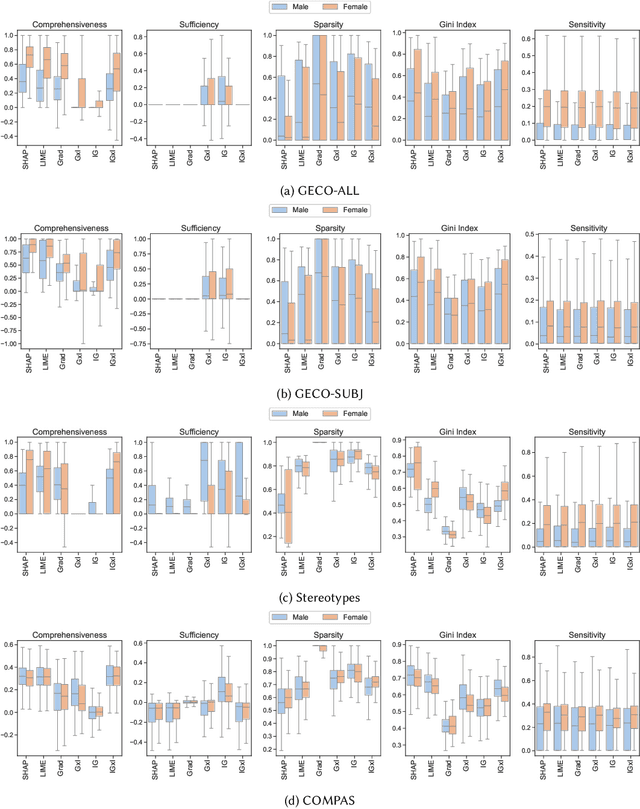
Abstract:While research on applications and evaluations of explanation methods continues to expand, fairness of the explanation methods concerning disparities in their performance across subgroups remains an often overlooked aspect. In this paper, we address this gap by showing that, across three tasks and five language models, widely used post-hoc feature attribution methods exhibit significant gender disparity with respect to their faithfulness, robustness, and complexity. These disparities persist even when the models are pre-trained or fine-tuned on particularly unbiased datasets, indicating that the disparities we observe are not merely consequences of biased training data. Our results highlight the importance of addressing disparities in explanations when developing and applying explainability methods, as these can lead to biased outcomes against certain subgroups, with particularly critical implications in high-stakes contexts. Furthermore, our findings underscore the importance of incorporating the fairness of explanations, alongside overall model fairness and explainability, as a requirement in regulatory frameworks.
Proceedings of the ISCA/ITG Workshop on Diversity in Large Speech and Language Models
Mar 12, 2025Abstract:Machine learning techniques have conquered many different tasks in speech and natural language processing, such as speech recognition, information extraction, text and speech generation, and human machine interaction using natural language or speech (chatbots). Modern techniques typically rely on large models for representing general knowledge of one or several languages (Large Language Models, LLMs), or for representing speech and general audio characteristics. These models have been trained with large amounts of speech and language data, typically including web content. When humans interact with such technologies, the effectiveness of the interaction will be influenced by how far humans make use of the same type of language the models have been trained on or, in other words, if the models are able to generalize to the language used by humans when interacting with the technology. This may lead to some gradual forms of adaptation in human speech and language production, and users who do not adapt may be excluded from efficient use of such technologies. On top of this, as commercial model development follows market needs, under-represented languages and dialects/sociolects may decrease in terms of priorities. Furthermore, for many lesser spoken languages the necessary data is not available, which will worsen a digital divide in speech and language technology usage. The workshop sets out to discuss this problem based on scientific contributions from the perspective of computer science and linguistics (including computational linguistics and NLP).
FitCF: A Framework for Automatic Feature Importance-guided Counterfactual Example Generation
Jan 01, 2025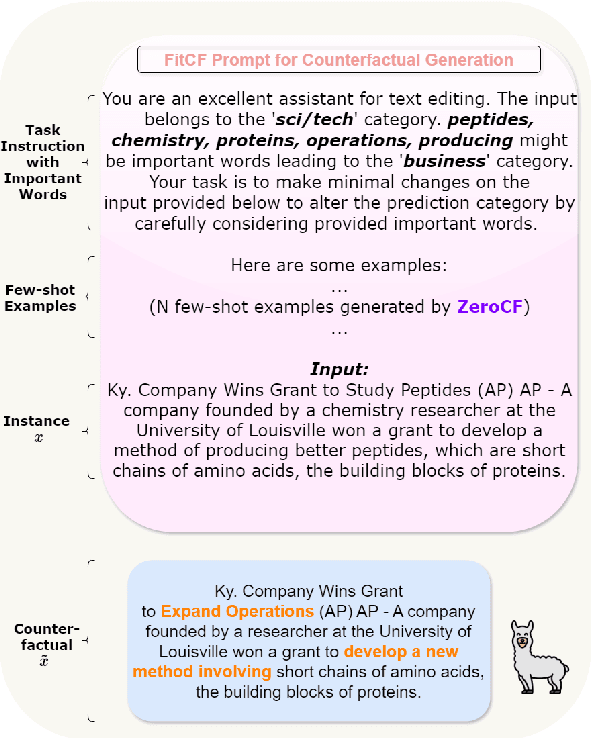
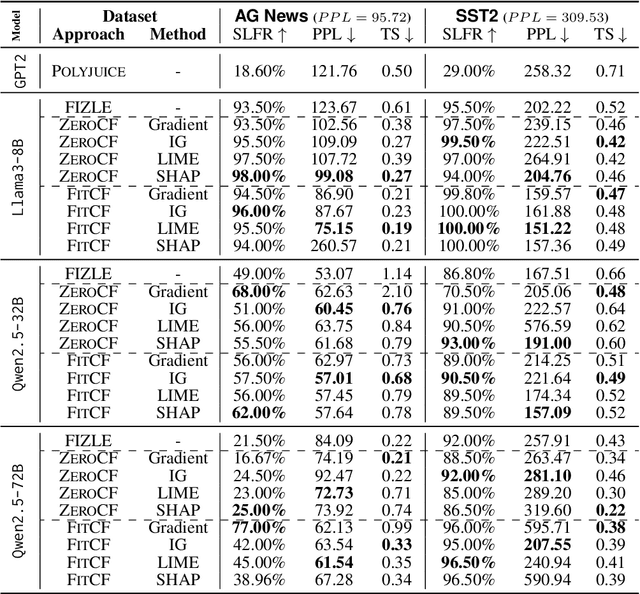
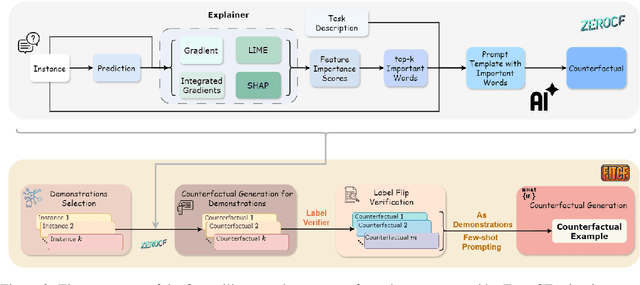
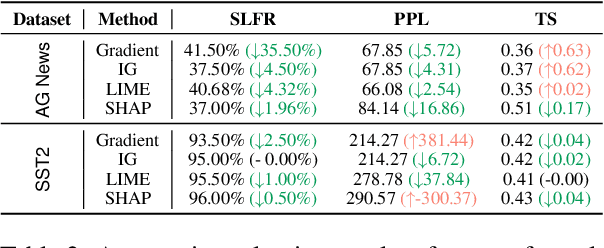
Abstract:Counterfactual examples are widely used in natural language processing (NLP) as valuable data to improve models, and in explainable artificial intelligence (XAI) to understand model behavior. The automated generation of counterfactual examples remains a challenging task even for large language models (LLMs), despite their impressive performance on many tasks. In this paper, we first introduce ZeroCF, a faithful approach for leveraging important words derived from feature attribution methods to generate counterfactual examples in a zero-shot setting. Second, we present a new framework, FitCF, which further verifies aforementioned counterfactuals by label flip verification and then inserts them as demonstrations for few-shot prompting, outperforming two state-of-the-art baselines. Through ablation studies, we identify the importance of each of FitCF's core components in improving the quality of counterfactuals, as assessed through flip rate, perplexity, and similarity measures. Furthermore, we show the effectiveness of LIME and Integrated Gradients as backbone attribution methods for FitCF and find that the number of demonstrations has the largest effect on performance. Finally, we reveal a strong correlation between the faithfulness of feature attribution scores and the quality of generated counterfactuals.
Cross-Refine: Improving Natural Language Explanation Generation by Learning in Tandem
Sep 11, 2024Abstract:Natural language explanations (NLEs) are vital for elucidating the reasoning behind large language model (LLM) decisions. Many techniques have been developed to generate NLEs using LLMs. However, like humans, LLMs might not always produce optimal NLEs on first attempt. Inspired by human learning processes, we introduce Cross-Refine, which employs role modeling by deploying two LLMs as generator and critic, respectively. The generator outputs a first NLE and then refines this initial explanation using feedback and suggestions provided by the critic. Cross-Refine does not require any supervised training data or additional training. We validate Cross-Refine across three NLP tasks using three state-of-the-art open-source LLMs through automatic and human evaluation. We select Self-Refine (Madaan et al., 2023) as the baseline, which only utilizes self-feedback to refine the explanations. Our findings from automatic evaluation and a user study indicate that Cross-Refine outperforms Self-Refine. Meanwhile, Cross-Refine can perform effectively with less powerful LLMs, whereas Self-Refine only yields strong results with ChatGPT. Additionally, we conduct an ablation study to assess the importance of feedback and suggestions. Both of them play an important role in refining explanations. We further evaluate Cross-Refine on a bilingual dataset in English and German.
Free-text Rationale Generation under Readability Level Control
Jul 01, 2024Abstract:Free-text rationales justify model decisions in natural language and thus become likable and accessible among approaches to explanation across many tasks. However, their effectiveness can be hindered by misinterpretation and hallucination. As a perturbation test, we investigate how large language models (LLMs) perform the task of natural language explanation (NLE) under the effects of readability level control, i.e., being prompted for a rationale targeting a specific expertise level, such as sixth grade or college. We find that explanations are adaptable to such instruction, but the requested readability is often misaligned with the measured text complexity according to traditional readability metrics. Furthermore, the quality assessment shows that LLMs' ratings of rationales across text complexity exhibit a similar pattern of preference as observed in natural language generation (NLG). Finally, our human evaluation suggests a generally satisfactory impression on rationales at all readability levels, with high-school-level readability being most commonly perceived and favored.
 Add to Chrome
Add to Chrome Add to Firefox
Add to Firefox Add to Edge
Add to Edge